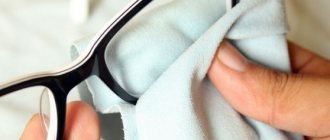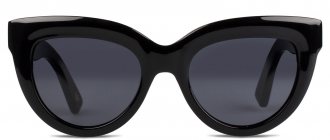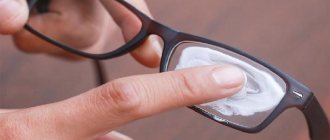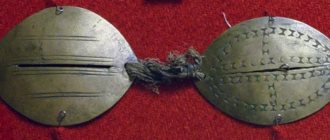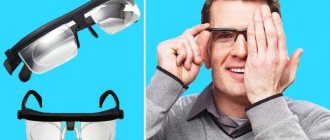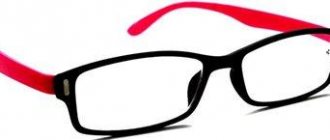For most people, especially if there is a refractive error such as farsightedness, when working at a computer for a long time, rapid fatigue, pain, tingling, and other discomfort in the eye area appear. Correctly selected glasses can help solve this problem.
Due to the fact that today it is almost impossible to do without using a computer, which significantly increases visual stress, the number of people suffering from eye diseases is regularly growing. One of the most common complaints in
In this article
- Why does discomfort occur and vision is impaired when working at a computer?
- The occurrence of farsightedness and presbyopia: what glasses are needed?
- Recommendations before visiting a specialist
- How to choose glasses for farsightedness?
- How to choose the right glasses for farsightedness when regularly working at a computer?
ophthalmological practice - asthenopia. This is rapid eye fatigue associated with long work at close distances. This functional disorder is accompanied by a burning sensation, with the sensation of a foreign object in the eyes, profuse lacrimation, and photophobia. In the future, vision deterioration may occur, the picture becomes blurred, which is associated with a spasm of accommodation.
According to the data obtained by Bulgarian scientists after conducting a study, 35% of subjects have a decrease in visual acuity when using a computer regularly. 45% of them cannot focus on objects located at different distances, as a result of which myopia occurs or hidden farsightedness begins to progress. And in 52% of the subjects there is a violation of convergence - the ability to bring together the visual axes of both eyes on a specific object. In addition, if under normal conditions a person develops presbyopia (age-related farsightedness) at an average age of 45 due to hardening of the lens (a biconvex natural lens), then under heavy loads it can begin to progress earlier.
Why does discomfort occur and vision is impaired when working at a computer?
Many people think that discomfort while working at a computer occurs due to the radiation that the display produces. However, this opinion is wrong. Since modern screens are equipped with a very low level of electromagnetic radiation (indicators can range from 60 kHz to 300 kHz). In fact, the real reason for the negative impact on vision health is regular, intense eye work, which has certain specifics.
Thus, the visual organs have to receive information not from a horizontal plane (for example, from a sheet of paper), but from a vertically located surface. In addition, glare, the glow of the display, the frequency of its flickering and a static posture for a long time make the eyes very strained. If the usual frequency of blinking in a person is approximately 15-20 times per minute, then during the period of work at the computer this figure decreases to 1-5 times per minute.
That is why, when working with this device, the user's tear film dries out and the conjunctiva of the cornea of the eyes becomes dry. This deviation is called “dry eye” syndrome. Also, rapid fatigue is associated with the need to move your gaze from the keyboard, to documents, and then to the screen. The correct arrangement of lighting and workplace, as well as the distance from the user to the monitor, is very important.
Classification of photochromic lenses for glasses
The main characteristic of photochromic lenses is the degree of darkness. This parameter is denoted by the abbreviation VLT - Visible Light Transmission. The higher the percentage of light transmission, the more transparent the lens appears. Thus, glasses with an S0 value transmit from 80 to 100% of light; they are worn indoors - for example, they are used for computer glasses. The maximum value is S4. Such lenses are used by climbers or residents of settlements located high in the mountains: optical products transmit only 3-8% of visible light.
For a comfortable life in the city, glasses with a light transmittance index of S2-S3 are enough: this is enough to feel comfortable in the bright sun, at dusk, and in partly cloudy weather. For photochromic prescription glasses, the VLT usually starts at S0 (90-95% of visible study is missed) and goes up to S3 (10-15% is missed).
Photochromic glasses can have lenses made of glass and plastic. It is important to note that specially developed complex composite materials such as Trivex are used to produce optical products today, so polymer lenses are very different for the better from those that were in use 20-30 years ago. We have listed the key pros and cons of each option in the table.
| Advantages | Flaws | |
| Plastic lenses | Minimum weight. Glasses are practically not felt on the face, so they are well suited for vision correction. In addition, they look more elegant. Low risk of injury. If plastic lenses break, they will become covered with a network of cracks, but will not shatter into small fragments. Plastic lenses are recommended for children and people leading an active lifestyle. Possibility of producing lenses with double curvature at an affordable price. | Fragility. In terms of average service life, plastic lenses are inferior to glass ones. In order for plastic lenses not to harm the eyes and to be durable, they must be made of modern materials and covered with several protective layers. You need to buy lenses from trusted brands and in stores that are an official representative or are ready to give a guarantee. |
| Glass lenses | Suitable for correcting severe cases of myopia and farsightedness. Not exposed to high and low temperatures. They have “built-in” UV protection. | Discomfort. Due to the heavy weight, the glasses put pressure on the bridge of the nose and leave marks on it. Risk of eye damage from shrapnel if lenses break |
The occurrence of farsightedness and presbyopia: what glasses are needed?
The onset of presbyopia (age-related farsightedness) occurs between the ages of 35-40 years, and its progression continues until 60 years. Such changes in vision imply the selection of glasses for good visibility of objects not only near, but also in the distance. When using a computer, people with presbyopia may experience headaches, eye pain, blurred vision, and decreased clarity. How to choose glasses for farsightedness? Only an ophthalmologist can do this. As a rule, with severe degrees of pathology (from +5 diopters), it becomes necessary to choose the right two pairs of glasses with different optical parameters. Or glasses with multifocal lenses, which have several optical zones for near and far vision.
To select glasses for farsightedness, during the examination the specialist has to take into account not only the degree of decrease in visual ability, but also the strength of the ciliary muscle, the conditions in which the patient works, as well as his lifestyle. Before going to see a doctor, it is recommended to measure the distance from the bridge of your nose to the monitor, then it will be easier for the ophthalmologist to prescribe glasses for the computer.
Tips for choosing
If you decide to purchase this necessary accessory, but do not know on what basis (other than price) to make your choice, make a decision based on the type of your activity. If you write texts, then optics that enhance contrast and remove halftones are suitable for you. If you are dealing with graphic editors, then you need glasses that improve color reproduction. Well, if you hang out at the monitor for a long time, choose a product with anti-reflective lenses.
p, blockquote 17,0,0,0,0 –>
To choose the right glasses for your computer, consider the following criteria:
p, blockquote 18,0,0,0,0 –>
- Lens type. They are anti-reflective (screen out reflected light), bifocal (divide the display into 2 optical areas), monofocal (expand the field of view), progressive (have 3 viewing segments). An ophthalmologist will help you choose the right type.
- Frame quality. It must be made of good material, otherwise the frame will press, causing discomfort.
- Manufacturer. A guaranteed quality product is produced in Germany, Switzerland, Japan, and Korea.
Naturally, price is also important. But on the Internet they can also offer you a low-quality product at a high cost (and this is not surprising). Don't be naive, consider all the criteria before purchasing.
p, blockquote 19,0,0,0,0 –>
Recommendations before visiting a specialist
If you need to choose glasses for farsightedness, or for working at a computer, consider the following:
- Contact your doctor at a time when your vision has not been subjected to heavy strain during the day;
- Before the examination, it is not recommended to consume alcoholic beverages, as they have a negative effect on the retinal sensitivity of the eyes and their muscle tone.
- If you have high blood pressure, headaches or generally poor physical health, you should postpone the selection of the necessary farsightedness glasses to another day.
- It is recommended to take with you the glasses you have previously used. This will help the specialist take into account the changes that have occurred in visual ability. If you have experienced discomfort while using your old glasses, you should report these symptoms to your doctor.
- During diagnosis, you need to tell the ophthalmologist about what types of activities you will be doing while wearing glasses. For example, working with documents or at a computer, driving a vehicle, etc.
- When choosing frames for glasses, pay attention to your own feelings. It should not press on the bridge of the nose and ears.
People's opinions about computer glasses: a review of reviews
Those who already use PC glasses have different opinions about these accessories. The opinion depends on how the person chose glasses for working at the monitor. If the choice was made without the involvement of a specialist (without a prescription), then the reviews are most often negative (the eyes hurt, they get tired quickly, the problem is not solved).
When a person buys glasses for PC after consulting with an ophthalmologist and chooses this accessory on the doctor’s recommendation, the reviews are often positive: users note that their eyes get tired less often and less, there is no unpleasant sensation, redness appears less often or disappears altogether, and headaches do not bother them.
How to choose glasses for farsightedness?
To understand how to choose the right glasses for farsightedness, it is worth knowing the basic rules that the ophthalmologist relies on. It is also important to understand that farsightedness will progress when wearing glasses that were chosen incorrectly.
So, the specialist takes into account:
- The main distance from objects to the eyes. As a rule, this figure is 33 cm;
- The distance from the lenses of farsighted glasses to the eyes should be 12 mm. Otherwise, the lenses may change their optical effect;
- Vision indicators (both eyes may be different). To correct farsightedness, positive lenses with a “+” sign are required. A doctor can prescribe glasses only after identifying the optical power required for a person, which is determined by the degree of farsightedness. For this, a comprehensive vision diagnostics is carried out;
- Patient comfort when viewing objects at different distances;
- Anatomical features of the structure of the visual system;
- The degree of the disease and its type. For mild farsightedness, glasses are selected with classic monofocal lenses. And in the presence of moderate and severe degrees of pathology, as well as presbyopia, lenses with bifocal (two zones with different optical powers and visible borders), multifocal (three areas with different optical powers with a smooth transition for vision near, far and at medium distances) are needed. or progressive (with many areas for focusing, changing from top to bottom) lenses;
- Patient's lifestyle.
Special glasses for sports
Sports products are very relevant for active people. Changing the shade of your sunglasses improves your visual acuity on the tennis court, golf course or ski slopes. Manufacturers of sports glasses are also working on safety, protecting the eye sockets from many injuries.
The famous Edgar Davids wearing special sports glasses.
The only football player in the world who was allowed by FIFA to wear glasses in the game
To ensure that the items correspond to the functions they perform, individual components are made of impact-resistant polycarbonate. The metal base is not used in order to maintain the safety of the person's face.
How to choose the right glasses for farsightedness when regularly working at a computer?
To make wearing glasses as comfortable as possible, experts recommend paying attention to special coatings for lenses. To understand what kind of glasses people with farsightedness need to work at a computer, you need to know what types of coatings are available:
- With UV filter - protects eyes from ultraviolet radiation;
- Strengthening – resistant to mechanical damage and scratches;
- Polarizing - eliminates glare, flare and halos reflected from water, snow, road surfaces and other horizontal surfaces;
- Hydrophobic - water-repellent and resistant to stains, making glasses easier to care for;
- Anti-glare - reduces fatigue, prevents the negative effects of light.
It is the latter type of coverage that is necessary for people who often work at a computer and actively use gadgets, and also if they are diagnosed with farsightedness. What other coatings can be selected and combined with anti-reflective coatings will depend on the person’s habits and field of activity.
